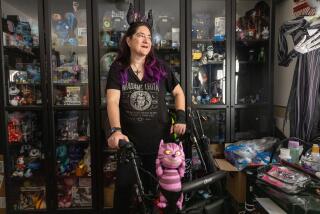Transport for Disabled Hits a Snag
- Share via
More disabled people than ever have access to low-cost transportation in San Diego County under new government rules. But because the rules increased access while leaving funding the same, more people also are waiting for a chance to climb aboard.
The first of the new rules went into effect five weeks ago, allowing unlimited rides to certified people, and allowing some new riders who are younger and wealthier onto the city’s Dial-a-Ride system by eliminating age and income restrictions.
The results have been thousands more ride requests each month, swamping a transit system already stretched to meet everyone’s needs in San Diego County. And transit workers are bracing for an estimated 40,000 more people that have yet to take advantage of the the new rules, implemented as part of the 1990 Americans With Disabilities Act.
Since 1978, the transit systems in San Diego have made sure that disabled people unable to use the buses can get rides in vans and cabs to college classes, grocery stores and doctor visits. Now these services have been brought under umbrella organizations that must operate along different priorities, leaving more people unsure whether their request for a needed ride will be granted, or forcing time limits on their travel.
“Excuse me, but my life doesn’t start and stop from 9 to 5,” said Kim Palmer, a 37-year-old North Park resident with multiple sclerosis.
The new rules say that only half the transportation service can be used for so-called “subscription” riders, who need rides to regularly scheduled events such as classes. The rest must get their rides on a catch-as-catch-can basis.
The result has been a dearth of subscription openings for people such as Palmer, who is supposed to go to physical therapy every day.
“I want my legs back,” she said. She is getting some rides through the American Red Cross, she said, but must hope each time for an available slot.
Palmer once used the city of San Diego’s Dial-a-Ride subsidies to pay for transportation in cabs and wheelchair-lift vans. But because of the new demand for transportation, Dial-a-Ride has shifted 400 of its clients to other ride services, some of which do not run on evenings and weekends, but the 400 slots were immediately filled again.
Palmer isn’t the only person who used to get regular service and now cannot get needed rides, said Karen Campos, Dial-a-Ride program manager.
“We just don’t have enough vehicles out here,” Campos said.
The disabilities act is touted as a civil rights act for disabled people, and transit services in San Diego County by 1996 must give equal service to people functionally unable to ride public transportation.
But while the disabilities act requires more access, it provides no extra funds, said Nancy Friedman, who is in charge of implementing the act through the Metropolitan Transit Development Board.
Officials say the transition to newly required operations will take more than just financial fine-tuning.
For one thing, many of the services, such as Lifeline in North County, have been offering low-cost rides to people 60 or older. As of Jan. 1, people who are certified to be disabled will be served first, leaving the non-disabled elderly on a waiting list.
The Dial-a-Ride system that serves the city of San Diego is just beginning to adjust its service to the new rules, and has yet to develop a plan to continue serving elderly and low-income people who do not qualify as disabled.
People who do qualify also get first crack at any openings in the regular rider “subscription service.”
“If you don’t make it as one of the lucky 50% who subscribe,” said Don Swain, transportation director for the American Red Cross, “you have to call every time you want a ride, and you take your chances.”
More to Read
Sign up for Essential California
The most important California stories and recommendations in your inbox every morning.
You may occasionally receive promotional content from the Los Angeles Times.













